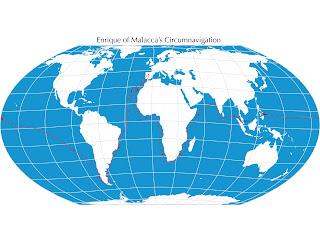A documentary from PBS features excellent footage of replica sixteenth-century Spanish carracks and how they were built: “Magellan’s Crossing,” an hour-long episode of the PBS series “Secrets of the Dead.”
The documentary starts off portraying Ferdinand Magellan as a great “explorer” and adventurer and moves on to introduce Juan Sebastián Elcano, who took command of the fleet a while after Magellan's death and led the circumnavigation.
But it also covers more-honest assessments, such as the riches Magellan stood to earn and more importantly the atrocities committed by Europeans in the Americas and elsewhere.
Not surprising for a short documentary, it contains some historical inaccuracies, but minor ones.
One plus, the film introduces Enrique of Malacca, Magellan’s slave and interpreter (and “confidant”). But one minus, for Enrique, they cast a middle-aged Asian actor with a gray beard—the real Enrique was likely in his mid-twenties during the circumnavigation voyage.
Subjects interviewed for the documentary span from shipbuilders in Spain making a replica sixteenth-century galleon to the crown prince of the Sultanate of Ternate and the prime minister of the Sultanate of Tidore—the legendary spice islands the Iberians sought.
It’s certainly a high-budget production.
The documentary premiered on Oct. 20, 2021, and is currently available on YouTube, as well as the PBS website:
(C) 2021 by John Sailors. All rights reserved.
Ferdinand Magellan’s historic journey swept up several unlikely travelers along the way, among them a seven-year-old boy at Guanabara Bay (Rio de Janeiro). Half-Portuguese, half-Tupi Indian, he is remembered in history as Joãozito Lopes Carvalho. The young boy became the first native of Brazil and likely all of South America to cross the Pacific Ocean—on a year-and-a-half journey that for him ended at Brunei five hundred years ago this summer.
Antonio Pigafetta's account of the Magellan-Elcano voyage gives us both first-hand historical detail and color—the human aspects of the journey. The Italian scholar learned all he could about the cultures that Magellan's fleet encountered, even sitting down and recording samples of languages.
An excellent example of Pigafetta's curiosity and fascination is his description of the coconut and the palm tree, which he learned about soon after the fleet's arrival in the Philippines. Like the pineapple Magellan tried in Rio, the coconut was an unknown. "Cocoanuts are the fruit of the palmtree. Just as we have bread, wine, oil, and milk, so those people get everything from that tree. Read more.
A handful of medieval travelogues were the closest thing Ferdinand Magellan had to a travel guide when he sought a westward route to Asia—accounts credited to Marco Polo, John Mandeville, and others, and those all echoed the same monsters and myths repeated since the time of Pliny the Elder, the Roman author whose Naturalis Historiae helped inspire the encyclopedia.
It gets little mention today, but The Travels of Sir John Mandeville was a world atlas of sorts in medieval Europe, essential reading for navigators and explorers. The accounts became circulated widely in Europe in the fourteenth century. They detail travels in North Africa and the Middle East, and in India, China, and even the Malay Peninsula—which would have been of particular interest to Ferdinand Magellan, and also Enrique of Malacca, Magellan’s interpreter-slave. Read more.
Reni Roxas and Marc Singer brought the story of Enrique to life for children in First Around the Globe: The Story of Enrique. Twenty years on they released this anniversary edition in 2017 from Tahanan Books, Manila. Read more.
On March 16, 1521, Magellan and his crew reached the Philippines, where they would finally be able to recover after three months crossing the Pacific. They were unable to stop long at Guam—their encounter with the Chamorros they met there did not go well, as seen in their sendoff. As they were departing, more than a hundred of the Chamorros’ outrigger canoes followed for more than a league.
- EnriqueOfMalacca.com
- Enrique of Malacca on Twitter
- Enrique of Malacca on Facebook
- John Sailors / Enrique on Medium
- And, yes, Enrique might be 500 years old, but he was known as a kid, so of course he's now on Instagram too.






